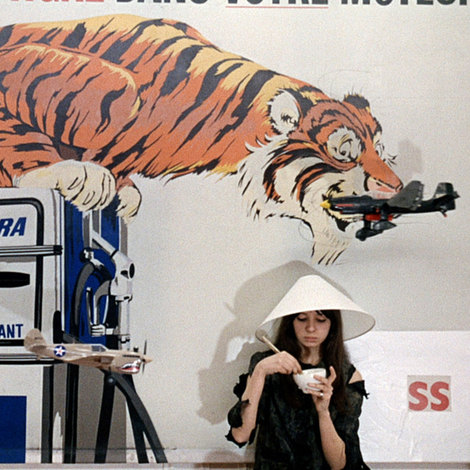Here is Sam Spade’s familiar “dingus,” bundled in vintage Chinese-language newspapers. As it should be. Because as anyone who’s seen The Maltese Falcon knows, the dingus—a jewel-encrusted, black-enamel-covered statuette of a falcon—arrived (on the La Paloma) from Hong Kong. But what’s remarkable is that this particular black bird, a to-scale falcon made by Tom Casesa, is only an inch high, which makes those to-scale newspapers it’s wrapped in … well, you’re definitely going to need your (full-size) reading glasses.

Casesa is a miniaturist—only by avocation, as good as he is. He was raised in Howard Beach, Queens, a third-generation-Italian son of a donut baker. Some years ago he left a corporate career (Lehman Brothers, Tiffany) and “sterile white box” of an Upper East Side apartment for the more creative environment of a West Village studio. “I was depressed. I was just doing numbers and figures,” he said. “So I started building things.”
Things like miniature dioramas: John and Yoko’s Toronto-hotel-room bed-in, the gorilla display from the African Mammals hall at the American Museum of Natural History, Holmes and Watson’s sitting room at 221B Baker Street—the latter complete with the bullet-etched “V.R.” on the wall. Naturally.

And things like a painstakingly detailed, one-twelfth scale (1 foot = 1 inch) replica of his own apartment—down to lamps, books, bed, LPs, briefcase, musical instruments, and so forth. He uses the tools of the trade—small table saw, X-Acto knives, special canvas paper for paintings, 3D printer—but farms out some work to specialists. “I subcontracted the leather armchair to a woman who’s very good at that,” he said of one particularly comfy-looking—if you were a vole of means, anyway—piece of furniture.
Everything is about fit and finish, Casesa learned in a course he took at the International Guild of Miniature Artisans in Castine, Maine. Precision is essential: something might look a little off and you won’t even know why.
You’re definitely going to need your (full-size) reading glasses.
The mini-apartment took a couple of years to complete. The mini black-walnut dresser (with pull-out drawers), which stores rather less than but which Casesa feels improves on the original, took about eight hours. “The real one is a nice enough piece,” he allowed, “but it’s not black walnut.” Casesa has also built a replica of the Waverly Inn, one of his favorite local joints, which—along with a devotion to the writing of the late, great Christopher Hitchens—led to a meeting with Waverly co-owner (and AIR MAIL co-editor) Graydon Carter. And, yes, one of the wee volumes in the apartment replica is Hitch’s Arguably.

As passionate as Casesa is about his “purest joy,” he also makes time for other hobbies—for instance, photography, as well as blues and jazz piano—and is not nearly as hard-core as it gets. “The real fanatics, if they’re doing a 16th-century piece, they’ll get the same wood,” he said, “and put it in filtered light for six months to age it.” Then there are the miniature-food purists. In case you were wondering, the answer is: “Yes. There is one guy out there who does make edible miniature food.”
If not everyone gets it, that’s fine. “I like things that trick the eye—magic tricks and things like that,” explained Casesa. “Because when you’re fooled, it’s a little tickle. And when you look at something of scale, it’s the same thing.” Well, we love it. As a to-scale Sam Spade (in an XXXXXXXS trench coat) might have observed: It’s the, uh, stuff tiny little dreams are made of.
George Kalogerakis is a Writer at Large for Air Mail


